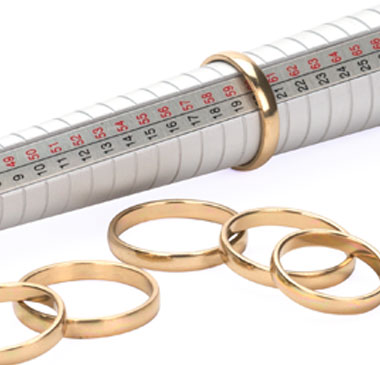PATIN-A Blog – Based on Experience
This blog shows how to patinate correctly, gives tips for the work in the costume department, shows the newest trends and introduces products and their use.
The main focus lies on costume distressing, leather working and textile dyeing. We show trends of the trade and aids for costume design.
Which textile dye do I use for which material?
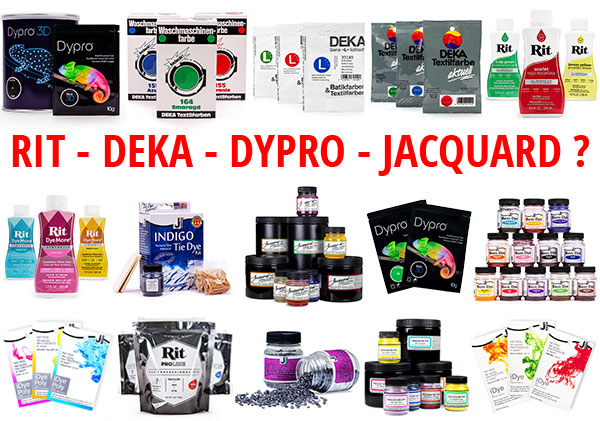
Which dye can be used to dye what?
"The dye from the drugstore hardly dyed my sweater - how can I get it black?"
Every day we receive inquiries from customers, which is the best or the right product to dye clothing, fabrics, wool or 3-D prints.
With this blog post, we would like to shed some light into the dark, show you the abundance of great dyes and give you some advice.
First things first:
• If a dye requires a specific temperature for dyeing, then you can dye the corresponding fibres/materials with it! No matter what temperature is written on the washing label.
• However, you should avoid strong movements of the textiles during the dyeing process (e.g. spinning) or shock temperatures (e.g. dye at 80 degrees and rinse at 10 degrees).
• For fabric mixes, appliqués or prints, you should pay attention to the manufacturer's washing temperature instructions. Otherwise, the garment may shrink partly or the appliqués may dissolve.
• Last but not least: All additives listed on the dye instructions are absolutely necessary for dyeing. If you omit products, you should not be surprised if the result does not turn out as desired.
Our list should help you find the right dye for your dye project.
We distinguish between vegetable, animal, cellulosic and chemical fibres.
Almost all fibres can be dyed! You just need to know with which product.
Click on the material you want to dye - you will immediately be redirected to the right dye.
Dyeing vegetable fibres:
The group of vegetable fibres is easy to dye. Almost all dyes on the market dye these fibres. Some better - some worse. There are very big differences in the quality of textile dyes.
PATIN-A only has dyes in its range with a high pigment density, in professional quality.
You can dye the plant fibres hot or cold and get an intensive dye result, except for grasses - they should definitely be dyed hot.
This group of textile dyes has to be fixed and needs salt in the dye liquor so that the dye can penetrate deeply. We distinguish between cold and hot dyes.
Cold dyes (dyeing at 40 to 60 degrees)
• Cotton
• Linen (flax)
• Hemp
• Bamboo
• Jute
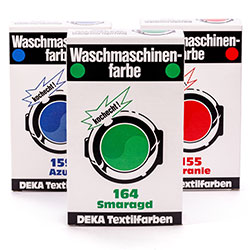 |
DEKA Machine Fabric Dye | With DEKA Machine Fabric Dye, it is easy to dye natural fibres. Use your washing machine for dyeing and dye your textiles light and wash fast at 40 to 60 degrees. With one pack, you can dye up to1kg of fabric. Apart from dye salt, the pack contains all thenecessary ingredients. Dyeing agent: Reactive dye |
 |
DEKA aktuell | DEKA aktuell is for dyeing in the bathtub of with the popular tie-dye techniques (batik). The result is wash- and light fast. In addition, you need dye salt and DEKA Reactive Agent (available in 10g & 500g) Dyeing agent: Reactive dyes |
 |
Jacquard Procion MX | With Jacquard Procion MX, you dye in the bathtub or with the popular tie-dye (batik) techniques. The result is wash- and light fast. In addition, you need dye salt and soda. (available in 18g & 227g) Dyeing agent: Reactive dyes |
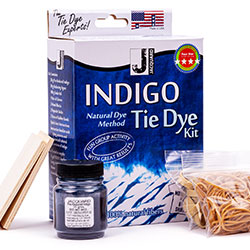 |
Indigo | Indigo ist a wonderful natural colorant - it is used for vat dyeing. The result is wash and light fast. In addition you need sodium carbonate (soda) andsodium hydrosulfite (in the Indigo Set, everything is already included) (available in 18g & 227g or as a set) Dyeing agent: Indigo natural dye |
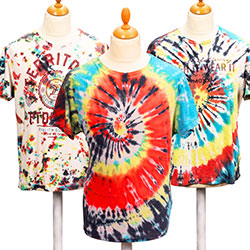 |
Tie-Dye Batik Dye Kits | Our Tie-Dye Kits take batik dyeing to a completely new level. Intensive bright colours make every T-shirt, sheet or towel an eye-catcher. You will find all the needed ingredients in the kit. Dyeing agent: Reactive dyes |
Hot dyes (dye at 80 to 95 degrees)
• Cotton
• Linen (flax)
• Hemp
• Bamboo
• Jute
• Grasses / Rattan / Bast
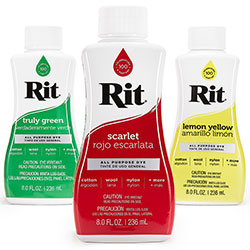 |
Rit All-Purpose Dye | The liquid Rit All-Purpose textile dye is the best known textile dye in the USA. This hot dye is most intensive at 80 degrees. We offer with this dye an interactive colour chart with which you can easily mix thousands of shades. In addition, you need dye salt and a fixative (so that the textiles can be washed at 40 degrees in the future). (available in 236 ml bottles) Dyeing agent: Mix of direct and acid dyes |
 |
Rit ProLine Dye | Rit ProLine textile dye is for professional users who need to dye large quantities.
It's a hot dye that dyes most intensively at 80 degrees. In addition, you need dyeing salt and fixative (so that the textiles can be washed at 40 degrees in the future) (available in 454g bags) Dyeing agent: Mixture of direct, acid and disperse dyes |
 |
Dypro Multi-Purpose Dye | Dypro Multi-Purpose dye is an internationally very popular, pigment-strong hot dye - for dyeing at 80 degrees. In addition, you need dye salt and a fixative (so that the textiles can be washed at 40 degrees in the future) (available in 10g, 250g & 500g) Dyeing agent: Mix of direct and acid dyes |
 |
Jacquard iDye Natural | iDye Natural is one of the most uncomplicated textile dyes for plant fibres. The colour pigments are in a sachet that you add to the dye pot or the washing machine, along with dye salt. In addition, you need a fixative (so that the textiles can be washed at 40 degrees in the future) (available in 14g sachets) Dyeing agent: Direct dyes |
 |
DEKA L | DEKA L Textile Dye is a very popular dye for tie-dye techniques, wax batik or for ombre dyeing. In addition, you need dye salt and a fixative (so that the textiles can be washed at 40 degrees in the future) (available in 10g, 250g & 500g) Dyeing agent: Mix of direct and acid dyes |
 |
Cochineal (Cochenille) | Cochineal = Pure nature! Dried cochineal lice with which you can dye fantastic intense reds. Depending on whether you add alum or tartar to the dye liquor, the dye result will be more red- or bluish. (available in 18g & 113g) Dyeing agent: Cochineal natural dye |
Dyeing animal fibres:
Animal or protein fibres need a lot of heat and an acidic dye liquor for an intensive dye.
Wool or animal hair will not felt if dyed exactly according to instructions! Dyeing in the washing machine is not recommended for these fibres.
• Wool
• Precious hair (cashmere goat, yak, angora, alpaca, camel etc.)
• Silk
• Feathers
| Dyes excellently: | ||
 |
Jacquard Acid Dye | This dye will inspire you! Jacquard Acid Dye is a pure acidic dye and the best dye for wool. In opposition to universal textile dyes that are mixed from direct dyes and acidic dyes, this is the pure dye that dyes protein fibres. It can also be used to dye wool, feathers and hair that seem undyeable with other textile dyes. In addition, you need vinegar so that the scales open and the colour can penetrate. (available in 18g, 227g & 454g) Dyeing agent: Acidic dye |
 |
Cochineal (Cochenille) | With the Cochineal dye you get an intense dye result with brilliant shades of red, purple and violet. Depending on whether you add alum or tartar to the dye liquor, the dye result will be more red- or bluish. (available in 18g & 113g) Dyeing agent: Cochineal natural dye |
| Dyes well: | ||
 |
Rit All-Purpose Dye | The liquid Rit All-Purpose textile dye is the best known textile dye in the USA. This hot dye is most intensive at 80 degrees. We offer with this dye an interactive colour chart with which you can easily mix thousands of shades. In addition, you need vinegar and a fixative (so that the textiles can be washed at 40 degrees in the future). (available in 236 ml bottles) Dyeing agent: Mix of direct and acid dyes |
 |
Rit ProLine Dye | Rit ProLine textile dye is for professional users who need to dye large quantities.
It's a hot dye that dyes most intensively at 80 degrees. In addition, you need vinegar and fixative (so that the textiles can be washed at 40 degrees in the future) (available in 454 g bags) Dyeing agent: Mixture of direct, acid and disperse dyes |
 |
Dypro Multi-Purpose Dye | Dypro Multi-Purpose Dye dyes many different fibre types, also animal fibres. That is why Dypro is very popular with costume departments. This highly pigmented hot dye is for dyeing at 80 degrees. In addition, you need vinegar and a fixative (so that the textiles can be washed at 40 degrees in the future) (available in 10g, 250g & 500g) Dyeing agent: Mix of direct and acidic dyes. |
 |
DEKA L | DEKA L Textile Dye not only contains direct dyes but also an acidic dye and thus dyes feathers, wool or hair. In addition, you need vinegar and a fixative (so that textiles can be washed at 40 degrees in the future) (available in 10g, 250g & 500g) Dyeing agent: Mix of direct and acidic dyes |
 |
Jacquard iDye Natural |
iDye Natural can dye silk as well as natural fibres. In addition, you need vinegar and a fixative (so that the textiles can be washed at 40 degrees in the future) (available in 14g sachets) Dyeing agent: Direct dyes |
 |
Indigo | With Indigo, you can also dye animal fibres. However, in most cases the dye result is not as intensive as with natural fibres. Be sure to add vinegar to the last rinse so that the wool becomes nice and smooth and does not felt. The result is wash- and light fast. In addition, you need sodium carbonate (soda) and sodium hydrosulfite ( included in the kit) / and also a little vinegar (available in 18g & 227g or as a kit ) Dyeing agent: Indigo natural dye |
 |
Jacquard Procion MX | With Jacquard Procion MX you can also dye wool. Many dyers also steam the wool (for fixing ) in the microwave or in the oven. Add soda to the dye liquor instead of vinegar or citric acid. In addition, you need dye salt and acid. (available in 18g & 227g) Dyeing agent: Reactive dyes |
• Dyeing pelts
Pelts (hair with the leather side) cannot be dyed with textile dyes.
Light coloured pelts can be carefully dyed with a hair colour.
Dyeing cellulosic chemical fibres:
The basic material of these fibres is vegetable. As the name suggests, they are obtained from cellulose, i.e. wood.
The fibres are natural polymers. However, they behave like natural fibres when dyed and can be dyed without any problems.
When dyeing, refrain from spinning, as the textiles shrink at high spin rates.
• Viscose
• Modal
• Acetate
• Lyocell (Tencel)
| Dyes excellently: | ||
 |
Dypro Multi-Purpose Dye | Dypro Multi-Purpose Dye is a very popular, intensive hot dye - for dyeing at 80 degrees. In addition you need dye salt and a fixative (so that the textiles can be washed at 40 degrees in the future) (available in 10g, 250g & 500g) Dyeing agent: Mix of direct and acid dyes |
 |
Jacquard iDye Natural | iDye Natural is an uncomplicated, intensive textile dye that dyes at 80 degrees. In addition, you need dye salt and a fixative (so that the textiles can later be washed at 40 degrees). (available in 14g sachets) Dyeing agent: Direct dye |
 |
DEKA L | DEKA L Textile dye is a highly pigmented hot dye for dyeing at 80 degrees. In addition, you need dye salt and a fixative (so that the textiles can be washed at 40 degrees in the future) (erhältlich in 10g, 250g & 500g) Dyeing agent: Mix of direct and acid dyes. |
| Dyes excellently - with restrictions: | ||
 |
Rit All-Purpose Dye | The liquid Rit All-Purpose textile dye dyes viscose and modal very well,
but not acetate or lyocell. It's a hot dye that dyes most intensively at 80 degrees. We offer you an interactive colour chart for this dye, with which you can easily mix thousands of colours. Additionally, you need dye salt and a fixative (so that the textiles can be washed at 40 degrees in the future) (available in 236 ml bottles) Dyeing agent: mixture of direct and acid dyes |
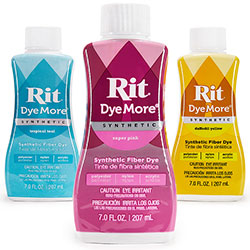 |
Rit DyeMore |
Rit DyeMore dyes acetate and lyocell excellently, but not viscose or modal!
This liquid dye is very easy to use. We offer with this dye an interactive colour chart with which you can easily mix thousands of shades. The fibres can be dyed very easily at 80 degrees. You need a fixative after dyeing. (available in 236 ml bottles) Dyeing agent: disperse or transfer dye |
| Dyes well: | ||
 |
DEKA Machine Fabric Dye | With DEKA Machine Fabric Dye it is very simple, as the name suggests, to dye in the washing machine (at 40 to 60 degrees). With one pack you can dye up to 1kg of textiles. Apart from the dye salt, you will find all the necessary ingredients in the packaging. Dyeing agent: Reactive dyes |
 |
DEKA aktuell | DEKA aktuell contains very intensive pigments and dyes in a tub or with the different tie-dye batik techniques. The result is wash- and lightfast. In addition you need dye salt and DEKA Reactive Agent (fixative). (available in 10g & 500g) Dyeing agent: Reactive dyes |
 |
Jacquard Procion MX | Jacquard Procion MX is a very popular dye from the USA. It is used to dye in a tub or for the different tie-dye batik techniques. The result is wash- and lightfast. In addition you need dye salt and soda (available in 18g & 227g) Dyeing agent: Reactive dyes |
Dyeing chemical fibres:
Polyester, polyamide, polyacrylic etc. are plastic fibres, but they have very little in common in terms of composition.
That means that not all poly is the same and these plastic fibres need (in most cases) different dye products.
3-D prints consist of polyamide and can be dyed penetratingly with the polyamide dyes.
 |
Jacquard iDye-Poly |
iDye Poly is the only polyester dye on the market that also dyes textiles. However, dyeing is sometimes problematic as some polyester fibres have been impregnated before manufacturing. That makes dyeing nearly impossible. Pure polyester can very easily be dyed at 90 degrees. Along with each 14g dye pack, you get a portion of iDye Poly Intensifier to intensify the colours. When purchasing the 454g tin you have to buy the intensifier separately. (available in 14g & 454g) Dyeing agent: Dispersion or transfer dye |
 |
Rit DyeMore |
Rit DyeMore dyes polyester and other synthetic fibres excellently.
It's a liquid dye very easy to use. We offer with this dye an interactive colour chart with which you can easily mix thousands of shades. Polyester is very easy to dye at 93 degrees. You do not need a fixative after dyeing. (available in 236 ml bottles) Dyeing agent: disperse or transfer dye |
• Polyamide (PA)
• Nylon (PA)
• Elastane (EL)
 |
Rit All-Purpose Dye | The liquid Rit All-Purpose textile dye is the best known textile dye in the USA. This hot dye is most intensive at 80 degrees. We offer with this dye an interactive colour chart with which you can easily mix thousands of shades. In addition, you need dye salt and a fixative (so that the textiles can be washed at 40 degrees in the future). (available in 236 ml bottles) Dyeing agent: Mix of direct and acid dyes |
 |
Rit ProLine Dye | Rit ProLine textile dye is for professional users who need to dye large quantities.
Dye at 90 degrees (don't worry - polyamide or nylon can withstand the heat). In addition, you need a little vinegar (a fixative is not needed). (available in 454g bags) Dyeing agent: Mixture of direct, acid and disperse dyes |
 |
Dypro Multi-Purpose Dye |
Dypro Multi-Purpose Dye dyes excellently polyamide, nylon, lycra and elastane. This dye is very popular and is used all over the world. Dypro is an excellent intensive hot dye - for dyeing at 80 degrees. In addition you need a little dye salt but no fixative. The dye penetrates the fibre deeply. (avalaible in 10g, 250g & 500g) Dyeing agent: Mix of direct and acid dyes |
 |
Jacquard iDye Poly | iDye Poly not only dyes polyester but also polyamide. But it is important to dye at 90 degrees. Along with each 14g dye pack you get a portion of iDye Poly Intensifier to intensify the colours. However, when buying a 454g tin you will have to buy the Intensifier separately. You do not need a fixative. (available in 14g & 454g) Dyeing agent: Dispersion or transfer dye |
 |
Jacquard Acid Dye | Jacquard Acid Dye also dyes polyamide, nylon, lycra and elastane. The dye temperature should be 80 degrees. This is not a problem, neither for the fibre nor for your garment! Add a little dash of vinegar to the dye liquor. You do not need a fixative. (available in 18g, 227g & 454g) Dyeing agent: Acid dye |
 |
Dypro Multi-Purpose Dye | Dypro Multi-Purpose Dye has always been very popular with plastic dyers and with the advent of 3D printing, it became a standard among users. The plastic parts are dyed at 80 degrees and get intense, bright colours. (available in 10g, 250g & 500g) Dyeing agent: Mix of direct- or acid dyes |
 |
Jacquard iDye Poly | iDye Poly is the only polyamide dye that dyes 3-D prints deep black. Several tests by large print shops have proven this. The other iDye shades are also very intensive. Dye temperature is 90 degrees. A portion of iDye Poly Intensifier is included with the 14g sachets, so that the colours will be more intensive. (available in 14g & 454g) Dyeing agent: Dispersion- or transfer dyes |
 |
Dypro 3D Black | Dypro 3D Black has been specially developed for black dyeing of 3D prints. The plastic parts are dyed at 80 degrees and get black. (available in 10g & 500g) Dyeing agent: Mix of direct- and acid dyes |
 |
Rit All-Purpose Dye | The liquid Rit All-Purpose textile dye is the best known textile dye in the USA. This hot dye is most intensive at 80 degrees. We offer with this dye an interactive colour chart with which you can easily mix thousands of shades. In addition, you need dye salt and a fixative (so that the textiles can be washed at 40 degrees in the future). (available in 236 ml bottles) Dyeing agent: Mix of direct and acid dyes |
 |
Rit ProLine Dye | Rit ProLine textile dye is for professional users who need to dye large quantities.
Dye at 90 degrees (don't worry - polyamide or nylon can withstand the heat). In addition, you need a little vinegar (a fixative is not needed). (available in 454g bags) Dyeing agent: Mixture of direct, acid and disperse dyes |
 |
Jacquard Basic Dye |
Jacquard Basic Dye is the only dye on the market that dyes polyacrylic intensively. In addition, you need vinegar. You do not need a fixative. The dye penetrates the fibre deeply. (available in 14g & 454g) Dyeing agent: Basic or cationic dye |
 |
Rit ProLine Dye | Rit ProLine dye can be used for polyacrylic dyeing.
The hot dye requires a dyeing temperature of 80 degrees. In addition, add a dash of vinegar to the dye liquor (a fixative is not needed). (available in 454g bags) Dyeing agent: Mixture of direct, acid and disperse dyes |
 |
Jacquard iDye Poly |
With iDye Poly you can also dye polyacrylic, at a dye temperature of 90 degrees. Depending on the amount of dye, with this dye you can only obtain light or medium colour tones. Which means that black is out of the question. However, you must never add iDye Poly Intensifier to the dye bath. (available in 14g & 454g) Dyeing agent: Dispersion- or transfer dye |
Mixed fibres:
Mixed fibres / blended fabrics are all textiles that consist of more than one type of fibre. Blends of cotton with polyester are very common, as the addition of polyester usually enhances the look of the garment.
Even with pure cotton products such as shirts, blouses, T-shirts etc. the seams are made of polyester and have to be dyed separately.
So you need a special dye for each type of fibre.
But there is one exception: extensible garments contain elastane (spandex). This addition is usually less than 10 or 20 percent. The elastane thread is transparent and so you only have to dye the main thread.
• Cotton-polyester blends
• Viscose-polyester blends
 |
+ |  |
iDye Poly + iDye Natural |
iDye Poly along with iDye Natural dyes your natural fibre blended fabrics evenly. Annoying seams in lighter colours are a thing of the past. In addition, you need dye salt and a fixative. Poly dyeing agent: direct dyes Natural fibre dying agent: disperse or transfer dye |
 |
+ |  |
Rit DyeMore + Rit All-Purpose Dye |
Rit DyeMore together with Rit All-Purpose Dye dyes
natural fibre blend fabrics evenly.
Disturbing seams in bright colours are thus a thing of the past. In addition, you need dye salt and fixative for the natural fibres. We offer with this dye an interactive colour chart with which you can easily mix thousands of shades. Poly dyeing agent: direct dyes Natural fibre dyeing agent: disperse or transfer dye |
 |
Jacquard Acid Dye | It is best to dye silk-wool blends with an acid dye! Jacquard Acid Dye is perfect for protein fibres and dyes intensive, bright colours. In addition, you need vinegar to open the scales so that the dye can penetrate. (available in 18g, 227g & 454g) Dyeing agent: Acid dye |
 |
Dypro Multi-Purpose Dye | Dypro Multi-Purpose Dye can dye both natural fibres and protein fibres. That is a great advantage of this hot dye. Dye temperature is 80 degrees. In addition, you need salt, vinegar and a fixative. Before fixing the fibres, add a dash of vinegar to the rinse cycle. (available in 10g, 250g & 500g) Dyeing agent: Mix of direct and acid dyes. |
 |
DEKA L |
DEKA L Textile Dye also manages to dye wool and cotton in one step. In addition, you need salt, vinegar and a fixative. Before fixing, be sure to rinse the textile once in vinegar water. (available in 10g, 250g & 500g) Dyeing agent: Mix of direct- and acid dyes |
 |
Rit All-Purpose Dye | The liquid Rit All-Purpose textile dye is the best known textile dye in the USA. This hot dye is most intensive at 80 degrees. We offer with this dye an interactive colour chart with which you can easily mix thousands of shades. In addition, you need dye salt and a fixative (so that the textiles can be washed at 40 degrees in the future). (available in 236 ml bottles) Dyeing agent: Mix of direct and acid dyes |
 |
Rit ProLine Dye | Rit ProLine textile dye is for professional users who need to dye large quantities.
It's a hot dye that dyes most intensively at 80 degrees. In addition, you need vinegar, dye salt and a fixative (so that the textiles can be washed at 40 degrees in the future). (available in 454 g bags) Dyeing agent: Mixture of direct, acid and disperse dyes |
Not dyeable:
It's impossible to list all the "non dyeable" materials here. This is a small part of the fibres often used in the textile industry:
• Imitation leather:
Imitation (synthetic) leather (smooth or suede) cannot be dyed in an immersion bath. But it is easy to paint the surface of smooth leather with elastic acrylic varnish.
For that, we recommend: Jacquard Airbrush Paint, Neopaque, Lumiere, Fiebings Acrylic Dye, TRG Leather Color Spray
• Microfibre
Unfortunately, there are only very few references to the original material of microfibre. Most microfibres are made of polypropylene which cannot be dyed under household conditions.
Microfibre from polyester is dyeable.
• Polypropylene (PP)
Polypropylene is the plastic from which are made e.g. plastic cups, shopping bags or foils. However, PP is also used for clothing. MIcro fibre clothing (e.g. fleece) is nearly exclusively made of polypropylene.
Polypropylene is not dyeable!
• Polyurethane (coated)
fibres
Garden furniture or outdoor clothing made of polyester often have an additional wetness protection made of polyurethane. These fibres are usually not dyeable. Unfortunately, you cannot remove this finish before dyeing.
Nor can it be detected either.
And finally:
If we forgot a specific fibre, just ask - we are happy to help!
Wishing you much success for your next dye :-)
(updated 12/07/2023)
 We ship worldwide
We ship worldwide Top customer satisfaction!
Top customer satisfaction! Many payment options
Many payment options






